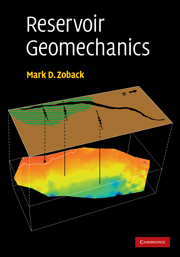Book contents
- Frontmatter
- Contents
- Preface
- PART I BASIC PRINCIPLES
- 1 The tectonic stress field
- 2 Pore pressure at depth in sedimentary basins
- 3 Basic constitutive laws
- 4 Rock failure in compression, tension and shear
- 5 Faults and fractures at depth
- PART II MEASURING STRESS ORIENTATION AND MAGNITUDE
- PART III APPLICATIONS
- References
- Index
- Plate section
4 - Rock failure in compression, tension and shear
Published online by Cambridge University Press: 10 December 2009
- Frontmatter
- Contents
- Preface
- PART I BASIC PRINCIPLES
- 1 The tectonic stress field
- 2 Pore pressure at depth in sedimentary basins
- 3 Basic constitutive laws
- 4 Rock failure in compression, tension and shear
- 5 Faults and fractures at depth
- PART II MEASURING STRESS ORIENTATION AND MAGNITUDE
- PART III APPLICATIONS
- References
- Index
- Plate section
Summary
In this chapter I review a number of fundamental principles of rock failure in compression, tension and shear that provide a foundation for many of the topics addressed in the chapters that follow. The first subject addressed below is the classical subject of rock strength in compression. While much has been written about this, it is important to review basic types of strength tests, the use of Mohr failure envelopes to represent rock failure as a function of confining stress and the ranges of strength values found for the rock types of interest here. I also discuss the relationship between rock strength and effective stress as well as a number of the strength criteria that have been proposed over the years to describe rock strength under different loading conditions. I briefly consider rock strength anisotropy resulting from the presence of weak bedding planes in rock, which can be an important factor when addressing problems of wellbore instability. This is discussed in the context of two specific case studies in Chapter 10.
In this chapter I also discuss empirical techniques for estimating rock strength from elastic moduli and porosity data obtained from geophysical logs. In practice, this is often the only way to estimate strength in many situations due to the absence of core for laboratory tests. This topic will be of appreciable interest in Chapter 10 when I address issues related to wellbore stability during drilling.
- Type
- Chapter
- Information
- Reservoir Geomechanics , pp. 84 - 139Publisher: Cambridge University PressPrint publication year: 2007
- 2
- Cited by



